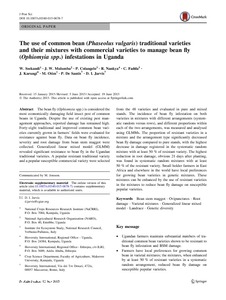Resource information
The bean fly (Ophiomyia spp.) is considered the most economically damaging field insect pest of common beans in Uganda. Despite the use of existing pest management approaches, reported damage has remained high. Forty-eight traditional and improved common bean varieties currently grown in farmers’ fields were evaluated for resistance against bean fly. Data on bean fly incidence, severity and root damage from bean stem maggot were collected. Generalized linear mixed model (GLMM) revealed significant resistance to bean fly in the Ugandan traditional varieties. A popular resistant traditional variety and a popular susceptible commercial variety were selected from the 48 varieties and evaluated in pure and mixed stands. The incidence of bean fly infestation on both varieties in mixtures with different arrangements (systematic random versus rows), and different proportions within each of the two arrangements, was measured and analysed using GLMMs. The proportion of resistant varieties in a
mixture and the arrangement type significantly decreased bean fly damage compared to pure stands, with the highest decrease in damage registered in the systematic random mixture with at least 50 % of resistant variety. The highest reduction in root damage, obvious 21 days after planting, was found in systematic random mixtures with at least 50 % of the resistant variety. Small holder farmers in East Africa and elsewhere in the world have local preferences for growing bean varieties in genetic mixtures. These mixtures can be enhanced by the use of resistant varieties in the mixtures to reduce bean fly damage on susceptible popular varieties.



